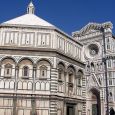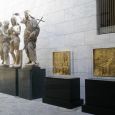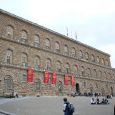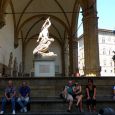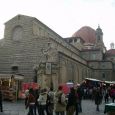Florence
Advertisement
By Air
Florence Amerigo Vespucci (FLR) airport is located 4 km from the city centre, with convenient airport transfer by bus to Santa Maria Novella train station in central Florence.
The bus service runs from Florence airport into the city centre at 30 minute intervals approximately, from around 6am until 11pm. The journey costs about 5 Euro.
By Train
Florence´s central train station is called Santa Maria Novella (SMV) and is the main train terminal for transport arriving and leaving Florence. Trains going to Bologna, Milan, Venice and Rome depart almost every hour.
Outside Santa Maria Novella train station you will find most of the major bus companies operating on regional routes.
The second station, Campo di Marte, is the terminal for some long-haul trains.
By Bus
The city bus network is made up of two companies that manage public transport in Florence. The buses are orange and there are bus routes all over the city that run frequently.
A single journey costs about 1 Euro, or pick up a day ticket for around 4 Euro.
A much more old-fashioned way of getting around the city is to go by horse and carriage! From most major sights, a horse and trap is a great alternative means of transport but be sure to agree on a price beforehand.
Advertisement
Baptistry of St John
The "Baptistry of St John" or, in Dante's words, "il bel San Giovanni", was completed about 1128 after 70 years of building. It is famous for the three massive bronze doors on the south, north and east sides and for the magnificent mosaics in its octagonal interior.
A number of builders were responsible for the construction of what, after 1128, was to serve as a baptistry. Its pleasing proportions and green and white marble scheme of decoration made it an architectural masterpiece that was to serve as a model for other European buildings. The three bronze portals - works of sculpture unsurpassed in the Western world - were added in the 15th century.
Cathedral Museum
A host of artists created notable works of art - sculpture, gold and silver items, embroidery, etc. - to furnish the Cathedral, the Campanile and the Baptistry. Security and weathering meant these could not be allowed to stay in place inside and outside the building, so at an early stage they were removed for safekeeping. Since 1891 they have been kept in the Cathedral Museum, the building that in the 15th c. had been the site of the studios and workshops for the artists and craftsmen working on the cathedral.
Over the portal of the Museo dell'Opera del Duomo - literally the museum of the cathedral building works - is a bust of Grand
Duke Cosimo I by Giovanni Bandini dell'Opera (1572).
Palazzo Pitti
The Palazzo Pitti ranks as Florence's most importance palazzo together with the Palazzo Vecchio (they are joined by a passage) and the Palazzo Medici-Riccardi. Its size is impressive - it covers a surface area of 32,000 sq. m/344,320 sq. ft, and its facade is 205m/224yd across, and 36m/118ft high at the center - and so is its architecture, an effect that is heightened by the way the square fronting it slopes slightly uphill towards it.
The art gallery (Galleria Palatina or Pitti) in the Palazzo Pitti is one of the most important in the world, almost on a par, so far as works of art are concerned, with the collections of the Uffizi. The palace also houses the Museo degli Argenti (Silver Museum), the Galleria d'Arte Moderna (Gallery of Modern Art), the Contini Bonacassi collection, the Museo delle Carrozze (Carriage Museum) and the Appartamenti ex Reali (Royal Apartments). In the adjoining Palazzina della Meridiana are the Galleria del Costume and the Collezione Contini Bonacossi.
Loggia dei Lanzi
Also known as the Loggia della Signoria, the Loggia dei Lanzi owes its name to the "Lanzichenecchi", or "Landsknechte", the German lancers stationed here as his guard by Cosimo I. Known too as the Loggia dell'Orcagna (after Orcagna, a major artist and its possible architect), this arcade on Florence's main square was built between 1376 and 1382 under the direction of Benci di Cione and Simone di Francesco Talenti, and it precisely counterpoints the Palazzio Vecchio.
The arcade, one of the finest examples of Florentine Gothic architecture, was used by the Republic for official ceremonies. This is where ambassadors and princes were received, Priors and Gonfaloniere installed. With the dissolution of the Republic the Loggia lost this political function and assumed a purely decorative role. After it was restored in the last century it resumed its original official use, and is now once again decked out with tapestries and garlands on festive occasions.
On the facade above the round arches are panels with allegorical figures of the cardinal and theological virtues, made by various artists to designs by Agnolo Gaddi (1384-1389). On the roof is a terrace from which there is access to the Uffizi Gallery.
San Lorenzo
San Lorenzo counts as one of the major sites of art in the Western world. The church of St Laurence, the Old Sacristy, the New Sacristy, the Princes' Chapel and the Laurenziana Library are works of the highest architectural importance in their own right and contain priceless art treasures. It was here, in their parish church, that the Medici, unrivaled as patrons, spurred on the artists of their city - Brunelleschi, Donatello and Michelangelo - to even greater achievements.
It is said that the church of San Lorenzo was founded by St Ambrose in 393 outside the city walls of that time. It was rebuilt in the 11th century in the Romanesque style. It was that important exponent of Florentine Renaissance architecture, Brunelleschi, who
was commissioned by the Medici (from 1419 onwards) to give it its present form. The work was completed after his death but in accordance with his plans by Antonio Manetti (1447-1460). Michelangelo supplied designs (drawings and models in the Casa Buonarotti) for the facade but they were never implemented, so the bare bricks are still visible.
Baroque reliquaries, made from silver, bronze and gold, by M. Soldani, G.B. Fuggini an others. Late 17th and early 18th century.
Information not available
July - August -> 31(°C) - Summer
January - February -> 2(°C) - Winter
Advertisement

